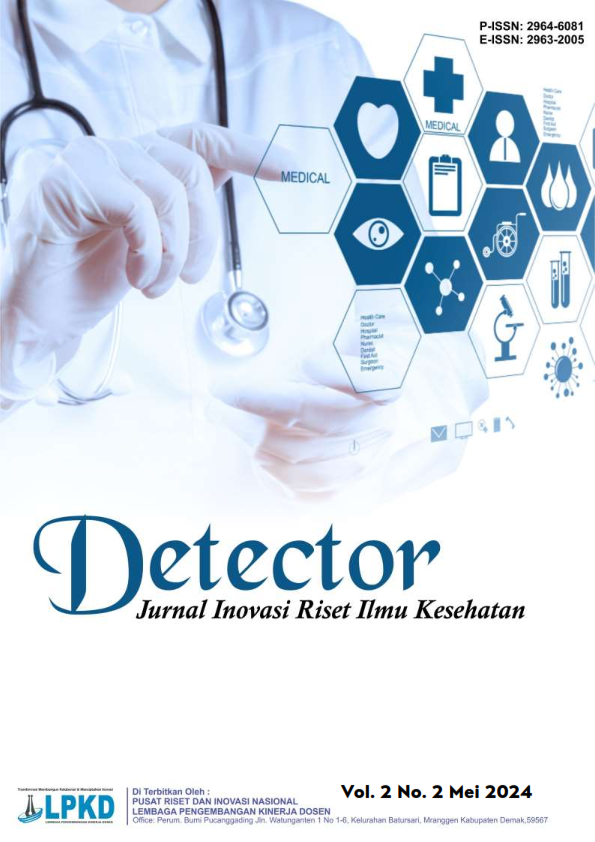Efektivitas Latihan ROM Pasif Ekstremitas Bawah terhadap Percepatan Bromage Score pada Pasien Post Spinal Anestesi
DOI:
https://doi.org/10.55606/detector.v3i1.4766Keywords:
Bromage Score, ROM, Passive ExercisesAbstract
Background: Spinal (subaracnoid) anesthesia is a regional anesthesia with the injection of local anesthetic drugs into the subarachnoid space. Spinal anesthesia can be given for procedures involving the lower limbs, pelvis, and perineum. Patients with spinal anesthesia are evaluated to determine whether or not the patient can be transferred to the ward. The indicator currently used is the Bromage Score, which is an indicator of the achievement of lower limb movement ability. The Bromage Score is an instrument for assessing the strength of the lower extremity muscles in patients after spinal anesthesia (Texas Children's Hospital, 2016). Full motion assessment score 0, unable to move the leg extremities score 1, unable to flex, but able to move the total leg score 2, unable to move the leg score 3. Purpose: To determine the effect of passive ROM exercises of the lower extremities with bromage score acceleration in post-spinal anesthesia patients. Research method: Using a quasi-experimental method with a posttest only control group design. The sample of this study amounted to 20 respondents, 10 respondents in the intervention group and 10 respondents in the control group. The intervention group performed passive ROM and the control group did not perform passive ROM. Sampling was done by consecutive sampling. The research instrument was an observation sheet, a watch. Results: The results of the statistical test used were Mann Whitney, after the P Value test = 0.000 (P Value <0.005). Conclusion: There is an influence between passive ROM exercises of the lower extremities and the acceleration of the bromage score in post-spinal anesthesia patients in the conscious recovery room.
Downloads
References
Asmadi. (2013). Konsep dasar keperawatan. Jakarta: EGC.
Azizah, N., & Hikayati, H. (2020). Pengaruh dan manfaat terapi range of motion (ROM) untuk peningkatan kekuatan otot pada pasien stroke (Doctoral dissertation, Sriwijaya University).
Bistara, D. N. (2019). Pengaruh range of motion (ROM) terhadap kekuatan otot pada pasien stroke. Jurnal Kesehatan Vokasional (JKESVO), 4(2), 112–117.
Daulay, N. M., & Hidayah, A. (2021). Pengaruh latihan range of motion (ROM) pasif terhadap kekuatan otot dan rentang gerak sendi ekstremitas pada pasien pasca stroke. Jurnal Kesehatan Ilmiah Indonesia (Indonesian Health Scientific Journal), 6(1), 22–26.
Dobson, M. B. (2004). Penuntun praktis anestesi. Jakarta: EGC.
Fatikha, M. (n.d.). Hubungan usia dengan waktu pencapaian Bromage score 2 pada pasien pasca anestesi spinal di ruang pemulihan RSU Negara.
Fitria, W. E., Fatonah, S., & Purwati. (2018). Faktor yang berhubungan dengan Bromage score pada pasien spinal anestesi di ruang pemulihan. Jurnal Ilmiah Keperawatan Sai Betik, 14(2), 182–186.
Hasanah, K. (2017). Penerapan latihan ROM aktif terhadap kekuatan otot pada pasien stroke non-hemoragik di RSUD KRMT Wongsonegoro Kota Semarang (Doctoral dissertation, Universitas Muhammadiyah Semarang).
Jitowiyono, S., Suryani, E., & Rachmawan, Y. (2017). ROM pasif ekstremitas dan waktu pulih sadar pasien dengan general anestesi post operasi elektif. Jurnal Keperawatan Terapan, 3(2), 110–117.
Kusuma, T. (2019). Pengaruh ROM pasif terhadap Bromage score pasien pasca spinal anestesi (Undergraduate thesis, Poltekkes Kemenkes Yogyakarta).
Mangku, G., & Senapathi, T. G. A. (2016). Buku ajar ilmu anestesi dan reanimasi. Jakarta: PT Indeks.
Nurwakit, A., Suwarni, L., & Rahayu, L. (2015). Pengaruh latihan pasif ekstremitas bawah dengan percepatan Bromage score pada pasien sectio caesarea post spinal anestesi diruang pulih sadar Rumah Sakit Tentara Slamet Riyadi Surakarta.
Potter, P. A., & Perry, A. G. (2013). Fundamental of nursing: Concept, process and practice (Edisi 8). Jakarta: EGC.
Rahayu, U. P. (2018). Pengaruh mobilisasi dini terhadap fungsi pernapasan pada pasien pasca operasi dengan anestesi umum di RSUD Wonosari (Unpublished undergraduate thesis, Poltekkes Kemenkes Yogyakarta).
Rika, N. (2022). Efektivitas penggunaan teknik spinal anestesi enhanced recovery after surgery (ERAS) dengan teknik spinal anestesi konvensional terhadap pencapaian Bromage score pada pasien seksio caesaria di recovery room RSU Muhammadiyah Lampung (Undergraduate thesis, Poltekkes Kemenkes Jogja).
Riska, & Susanti, B. A. D. (2020). Literatur review pengaruh range of motion (ROM) pasif terhadap kekuatan otot pada pasien stroke. Injection: Nursing Journal, 2(2), 78–91.
Setiyono, B. (2012). Pengaruh latihan pasif ekstremitas bawah terhadap peningkatan kesadaran pada pasien post operasi dengan anestesi general di ruang pulih sadar Rumah Sakit Tentara Slamet Riyadi Surakarta. Jurnal Keperawatan. Surakarta: Unisahid.
Sukma, I. M. (2020). Pengaruh pemberian Swedish massage terhadap Bromage score pada pasien pasca spinal anestesi di RS PKU Muhammadiyah Gamping Yogyakarta (Undergraduate thesis, Poltekkes Kemenkes Yogyakarta).
Suratun. (2008). Seri asuhan keperawatan klien gangguan sistem muskuloskeletal. Jakarta: EGC.
Texas Children’s Hospital. (2014). Procedural sedation. Evidence-Based Outcomes Center, 1(1), 1–20.
William. (2007). Perioperative nursing. Philadelphia: Mosby.
Wulandari, P., Shinta, S., & Andrianti, S. (2022). Pengaruh latihan pasif ekstremitas bawah terhadap percepatan Bromage score pada pasien post operasi apendiktomi di ruang pulih sadar Rumah Sakit Harapan dan Doa (RSHD) Kota Bengkulu. Injection: Nursing Journal, 2(2), 78–91.
Downloads
Published
How to Cite
Issue
Section
License
Copyright (c) 2025 Detector: Jurnal Inovasi Riset Ilmu Kesehatan

This work is licensed under a Creative Commons Attribution-ShareAlike 4.0 International License.








